
Wondering the best ways you can read books to your newborn? These tips will help any parent with how to read to baby.
Becoming a new parent can be really overwhelming. It comes with all sorts of questions and worries. One thing parents worry about is reading to their baby.
We have heard time and time again that reading to babies is important. But what is the best way to read to babies? What if my baby is wiggly and won’t look at the book? What books should I be reading to my baby?
These questions are valid and something I wondered about in the newborn trenches. The short answer to these questions is: keep it simple! Read on to learn more about reading to your baby.
This post is all about how to read to baby.
How To Read To Baby:
1. Create a Routine for Reading
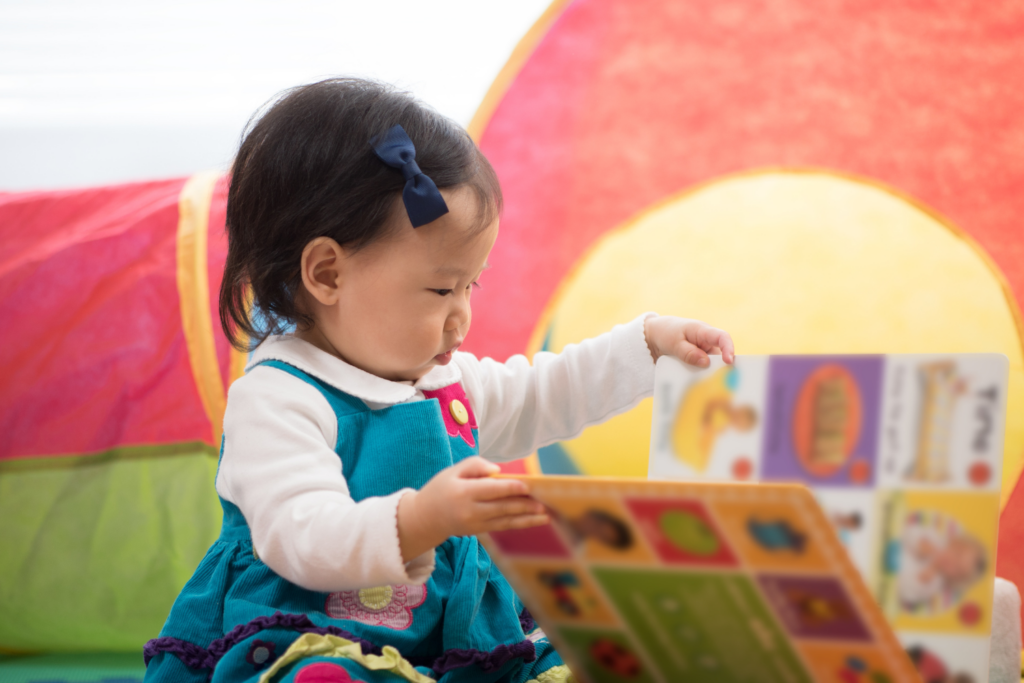
Reading to babies from birth is helpful for brain development, language development, and parent-child bonding. The best way to get all the benefits from reading to your child is to do it daily!
This is why creating a reading routine for newborns is essential. A reading routine is simply a time and place that you read with your child each day.
There are many different ways to set up a reading routine. Some options are:
- read books during morning playtime in the playroom
- read one book during each wake window wherever you are
- read books before naptime on the couch
- read books before bedtime in the nursery
By choosing a consistent time and place to read to your baby you can make a routine that will never be skipped. Once the habit of reading is formed, you and your baby will love the close snuggles and bonding time that reading books allows.
2. Get in a Position that Works for Your Baby
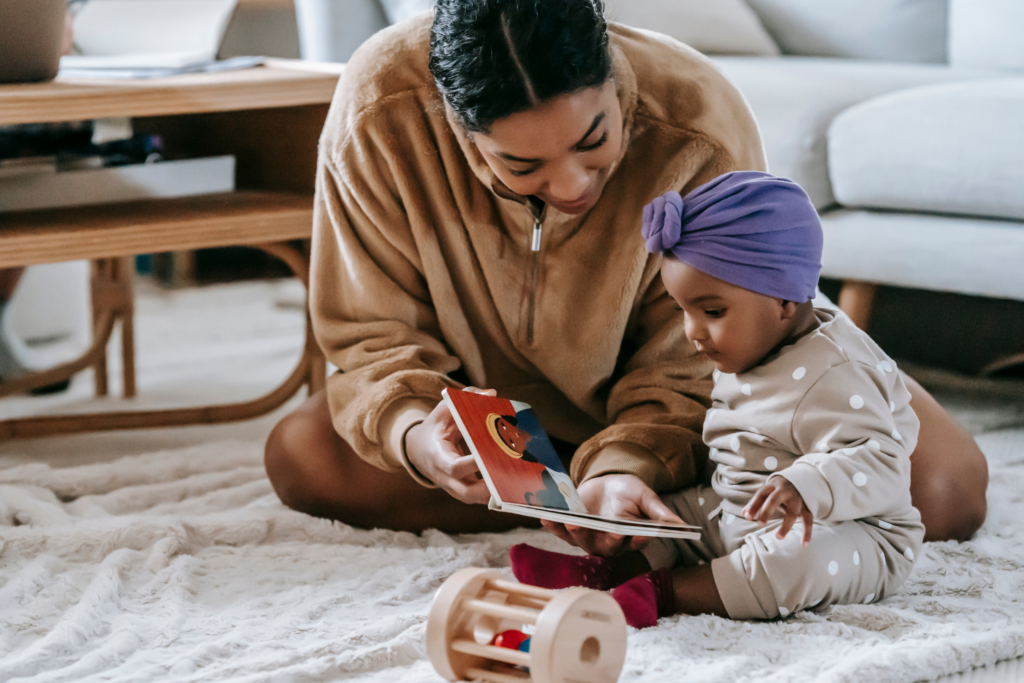
There are many different positions you and your baby can read in to make it comfortable for baby. By being creative about body positions during reading time you can engage baby and meet them at their level.
Some positions you can try for reading:
- lay down on the play mat next to your baby and hold the book above your heads
- hold your baby in your arms while sitting on a couch or chair
- sit your baby up in your lap on a couch or chair
- sit your baby up on the floor and hold the book in front of them
- while your baby is doing tummy time, hold the book in front of their face
- if your baby loves movement, hold a book in front of them while they are in the bouncer or activity table
- rock in the rocking chair while reading to your baby on your lap
If your baby doesn’t seem interested in reading it may be that they aren’t in a comfortable position. Adapting to your babies’ needs and choosing a reading position that works for them can make reading to your newborn go more smoothly.
3. Remove Distractions While Reading
When parents are wondering how to read to baby, one thing they should think about is removing distractions during reading time. This includes phones, tablets, TV, and music.
It’s easy for our adult brains to tune out the background noise of the TV or music, but it can be easily distracting for babies. They aren’t used to so much going on around them all the time like we are.
Shutting off all noise can really help babies get the most out of reading time. Plus their favorite sound is your voice; you are giving them a gift each time you take the time to read to them in a quiet environment.
4. Choose Engaging Books
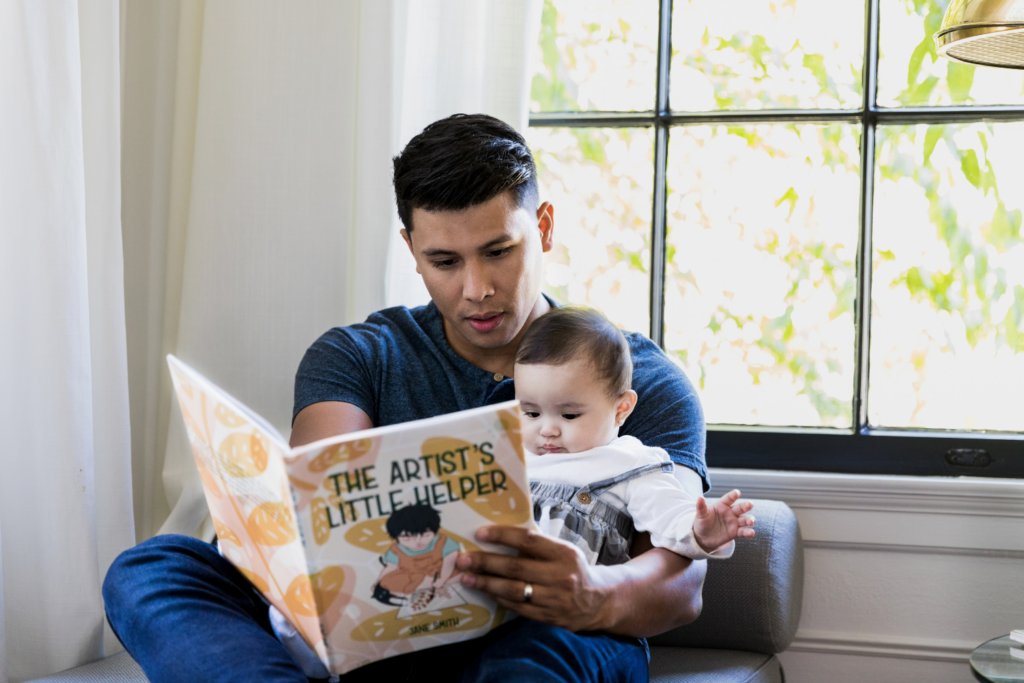
The options for engaging books for babies are endless! From board books to sensory books, you are sure to find something your baby will love to read. Read on to learn more about the different types of books for babies.
Board Books are classic and durable books for babies. The pages are made out of a strong cardboard-like material that allows babies to handle the books without fear that the pages will end up ripped or crumpled. You can find many stories in board book form.
Sensory Books are usually made of waterproof fabric and contain crinkly paper inside. When babies grab these books they make a satisfying noise that babies love. These books also come with different textures for baby to feel as you read.
High Contrast Books are often simple books with black-and-white pictures. Since newborns eyes take some time to fully develop, pictures that are high contrast help baby focus and attend to books.
As your baby gets a bit older, books with real faces are highly engaging for baby. Babies love to look at faces of people they love, and also love to look at faces of other babies in books!
Finally, books that are also songs are great for babies. Singing to your baby is wonderful for language development. If you don’t know baby songs or feel silly singing, find a song book that baby can pay attention to while you sing!
Check out this list of the best books for newborns to learn more about each type of book.
5. Read ANYTHING! No Really
In the beginning of your child’s life, the main benefit of consistent reading is language development and bonding. By simply hearing your voice read anything, your baby will begin to develop language skills.
So feel free to read anything! The newspaper, your favorite book, or a magazine are all good options.
Some people think that talking to your baby is enough for language development. While narrating your day and singing are excellent ways to build language for your baby, reading adds even more to this great foundation.
When we read, we usually use words that are different from when we speak. People have both receptive and expressive vocabulary. Receptive vocabulary is the number of words you understand, while expressive vocabulary is the number of words you use.
We all understand more words than we use on a daily basis. For example, a book may use the synonym “colossal” for the word big. We understand this word, but how often do we use it when speaking? Most of the time in spoken language people choose a simpler word to describe what they are trying to say.
The words that we use are also dependent on the context we are in. On a daily basis do you visit a beach, the mountains, or outer space? Maybe not. You’re more likely to visit places like the grocery store and the library.
By reading books about different people, places, and things you are using vocabulary that wouldn’t be relevant to your daily life. This exposure to language is extremely beneficial to baby!
Additionally, sentence structure and grammar in written text can be more complex than our spoken language. Books, articles, and other written word tends to be more formal. This exposure helps babies understand the complexities of our language.
It may seem over the top to think about complex sentence structure and obscure vocabulary words when discussing language development for babies, but any language exposure is good language exposure!
All of this to say, read whatever you want to baby. They are sure to get something out of it!
6. If Baby is Wiggly, Read to Them Anyway
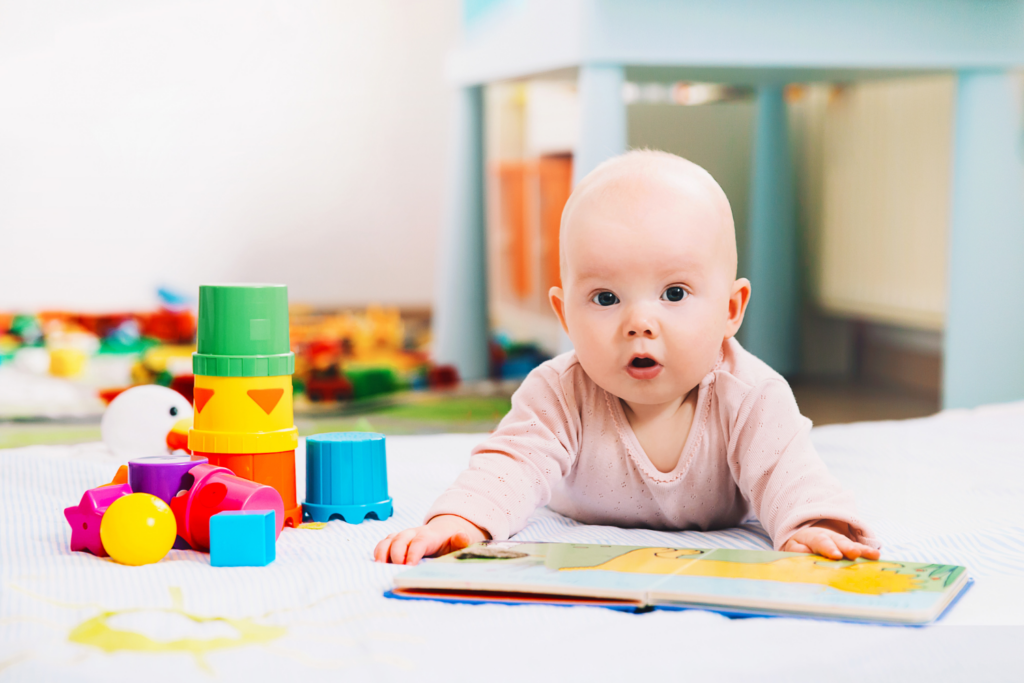
Is your baby moving around the whole time you try to read to them? Is he trying to roll over during tummy time instead of looking at the book? Is she looking anywhere else in the room besides the book? Are you wondering how to read to baby when they are wiggly and seem more interested in movement?
This is all normal and completely fine. Read to them anyway.
As discussed above, reading is about language exposure. Your baby does not need to be looking at the pictures in the book to benefit from reading. Simply hearing your voice and the complexities of language is wonderful!
Many babies go through phases with their interest in reading. They may be fully engaged one day, and couldn’t care less the next. When this happens, go with the flow of your baby, but persist in your reading routine.
You can read out loud next to your baby while they look in a mirror during tummy time. You can read aloud to your baby from across the room while they roll around. They will love the soundtrack of your voice for their exercise!
By committing to a reading routine you can read a few books with your baby and accept that this is not the season for focus on books. That time is sure to come if you continue to prioritize reading time daily with your child.
7. Use Fun Voices and Sounds to Engage Baby

One way to make reading time more engaging for baby is to use fun sounds and silly voices when reading the text. Your baby will love your playful spirit and it might help elongate the reading time.
Many children’s books come with fun language embedded in the text. You can find books that are entirely onomatopoeias. They include words like splash, bang, buzz, and fizzle.
You can also find books with animal noises. Animal noises like moo, woof, and cockadoodledoo count as words when your baby gets older and begins to speak. So practice your best cat meow when they’re little!
8. Visit the Library to Get New Books
The library is a treasure trove for little ones reading and language development. Did you know most libraries have a section of board books specifically for babies? You can check these books out just like any other library book.
The library also has great, free classes for parents like baby storytime. I highly encourage parents who have the time to go to baby storytime. Your baby will love the songs and books you read as a group, and you will get to socialize with other parents!
Each week, my son and I go to the library for baby storytime, and we also check out 10 board books. This routine helps us get out of the house while also keeping us entertained with new books at home. If you’ve read “Moo, Baa, La, La, La” 1,876 times you’ll want to check out new books from the library too!
9. Let Baby Play with Books
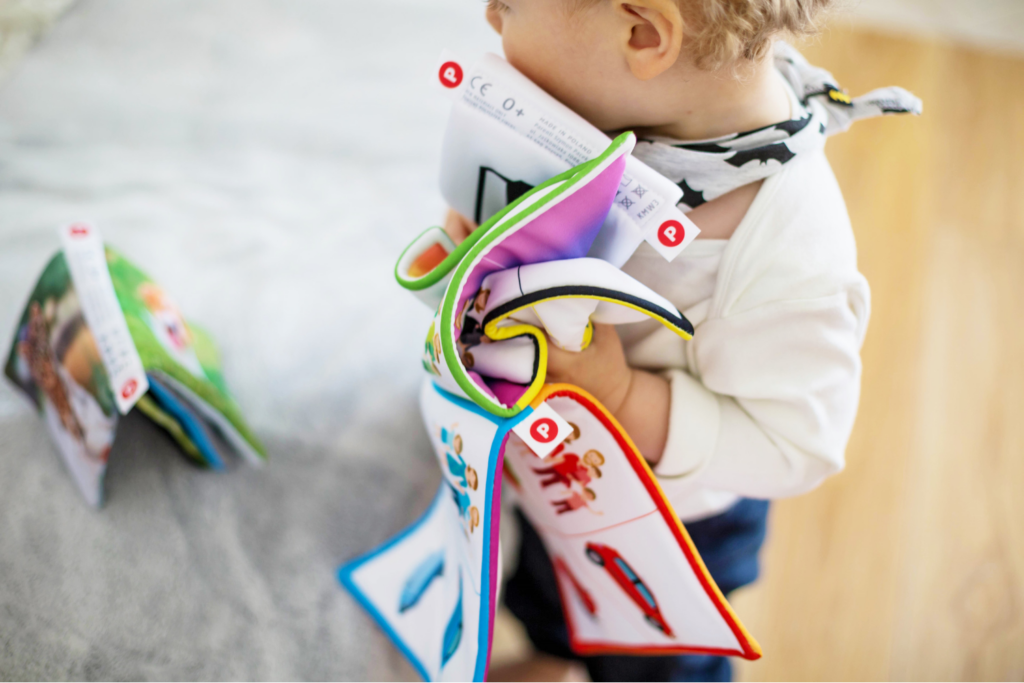
Books that are appropriate for babies include board books, sensory books, and other indestructible books. These books are great because your baby can hold them, play with them, throw them, and bite them without worrying about destroying a precious book.
When babies play with books they are developing important pre-reading and literacy skills such as print awareness. Print awareness, also known as concepts of print, is the knowledge of how printed text works.
This means the way a book opens, how to turn pages, the directionality of print, understanding letters go together to form words and understanding there are spaces between words.
By allowing your baby free reign over the book collection they will not only begin to develop print awareness but an interest in reading. Books are just like any other toy: a fun, engaging way to spend your time!
10. If Baby Just Wants to Put Books in Their Mouth – Let Them
Most babies will go through a phase where they put objects in their mouths. This is a normal part of their development, but can seriously hinder reading time.
If your baby is putting books in their mouth and that’s all they seem to want to do, then let them. This is normal and it’s okay.
One trick I used with my son was to give him a book to chew on while I read a different book. He got the satisfaction of exploring the book on his own, and I was happy knowing we got our reading time in.
Alternatively, you could read to your baby while they do something else. For example, read to them while they play in the activity center and keep their hands busy. Or you could give your baby a teether during reading time.
It’s easy to feel discouraged to read when your baby seems uninterested in the text, but continue to keep up with your routine, and this phase will pass!